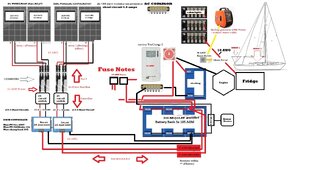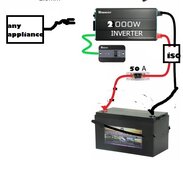Been Working on building out my electrical and solar plan on my sailboat. Asking for helpful comments on my plan and clarification on questions I still have.
Two MPPT controllers \ Two Arrays (redundancy\as well as to compensate for shade \ etc)
Really looking for major flaws or safety issues....
Thanks in advance. Appreciate the advice. Major Questions:
1.) Overall do you see any safety or major design issues with this layout / Solar portion?
2.) Is 14 AWG suitable between panels and combiners?
3.) Is 10 AWG suitable between MPPT and Batteries?
4.) 25 AMP cut off switches between combiners and MPPT for easy disconnection?
5.) 15 Amp FUSE at Battery In Line MC4 Fuses?
6.) (see pic of my battery bank) unsure which posts to connect to to have it balanced properly
7.) 3x 105 AH AGM Batteries (315 total amps 1/2 useable) - assuming 4 to 5 hours of sun - am I correct to assume I should see about 100 to 125 AH going back into the bank each day?
8.) If I use a plug to 30 AMP cable for my generator, I assume just firing up the generator and flipping on shore power (1600 watts running) about 13 AH an hour going back into the bank? Is my math correct? Anything extra needed other then regular plug to 30 amp plug?
9.) I am considering putting in an invertor. This would be to charge laptops or run small appliances. I would keep everything at (appliances and charges) 1000 watts or less that would use it. (occasional use items) - What would be safe specs and recommendations for an invertor that would not damage my AGM batteries? What posts and wire size would I use to connect the invertor to the batteries?
10.) Is there a way to bypass the invertor if using shore power?
Two MPPT controllers \ Two Arrays (redundancy\as well as to compensate for shade \ etc)
Really looking for major flaws or safety issues....
Thanks in advance. Appreciate the advice. Major Questions:
1.) Overall do you see any safety or major design issues with this layout / Solar portion?
2.) Is 14 AWG suitable between panels and combiners?
3.) Is 10 AWG suitable between MPPT and Batteries?
4.) 25 AMP cut off switches between combiners and MPPT for easy disconnection?
5.) 15 Amp FUSE at Battery In Line MC4 Fuses?
6.) (see pic of my battery bank) unsure which posts to connect to to have it balanced properly
7.) 3x 105 AH AGM Batteries (315 total amps 1/2 useable) - assuming 4 to 5 hours of sun - am I correct to assume I should see about 100 to 125 AH going back into the bank each day?
8.) If I use a plug to 30 AMP cable for my generator, I assume just firing up the generator and flipping on shore power (1600 watts running) about 13 AH an hour going back into the bank? Is my math correct? Anything extra needed other then regular plug to 30 amp plug?
9.) I am considering putting in an invertor. This would be to charge laptops or run small appliances. I would keep everything at (appliances and charges) 1000 watts or less that would use it. (occasional use items) - What would be safe specs and recommendations for an invertor that would not damage my AGM batteries? What posts and wire size would I use to connect the invertor to the batteries?
10.) Is there a way to bypass the invertor if using shore power?






